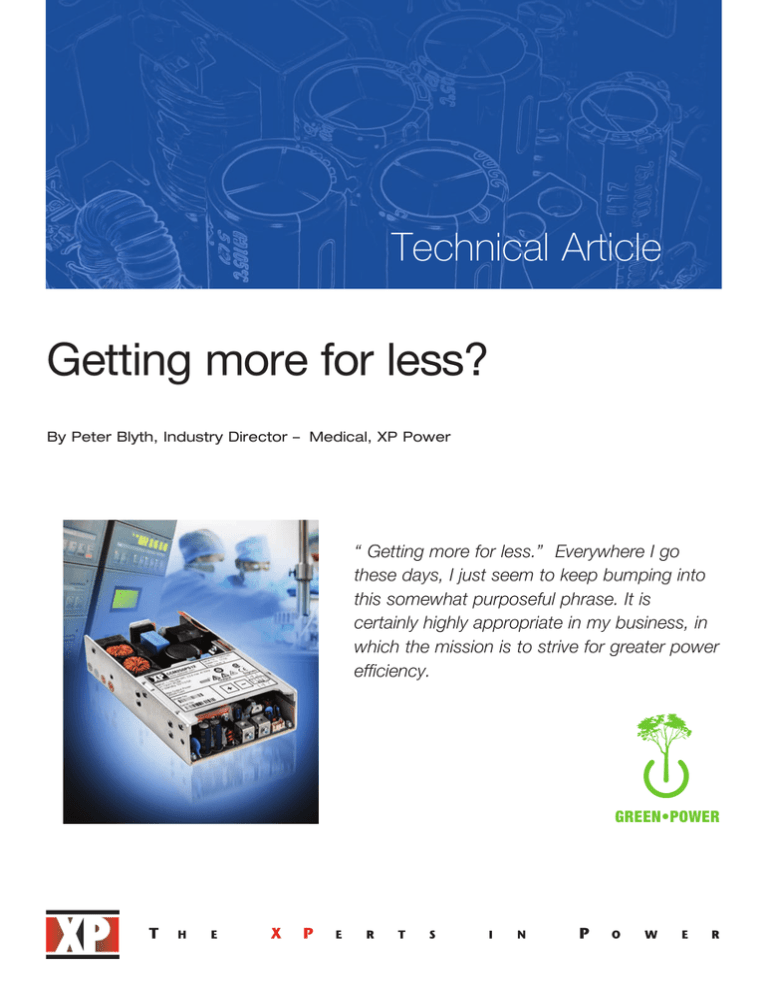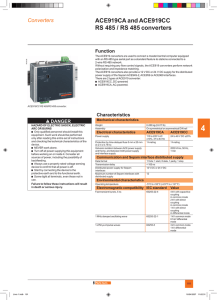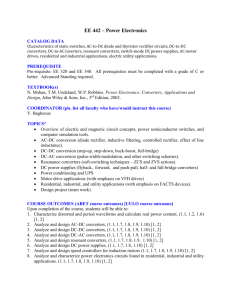Getting more for less?
advertisement

Technical Article Getting more for less? By Peter Blyth, Industry Director – Medical, XP Power “ Getting more for less.” Everywhere I go these days, I just seem to keep bumping into this somewhat purposeful phrase. It is certainly highly appropriate in my business, in which the mission is to strive for greater power efficiency. GREEN•POWER xppower.com It’s perhaps an obvious statement to say that ‘green’ issues are becoming more and more important in all our lives. Governments, global institutions and organisations, multinational and local businesses, and individuals alike are acutely aware of the new reality of steeply rising energy prices and dwindling global energy resources overall. And what’s more, all the evidence is that the principal energy sources currently being employed, such as oil and coal, aren’t very good for our planet, its ecosystems, and specifically for our societies. Among all the possible solutions currently on the table to reduce greenhouse gas emissions, the headlines are usually grabbed by discussions on the increased replacement of fossil-based fuels with either nuclear power or renewable energy sources such as solar or wind power, at either the global or national level. And perhaps on an individual level, we’re informed that we should fly less or invest in a hybrid or electric car; or better still, leave the car at home and use public transport or a bike even. Certainly, all the predictions say that on a global scale our consumption habits are only going to increase over the next few decades. So, to come back to my original thought, perhaps what we should also be talking about is getting better value from the energy we do consume, and get more for less. Figure 1. Power Consumption MWH/y by category, number of equipment and percentage of total 2 xppower.com It’s clear that a multitude of different technologies in vastly differing fields are going to come into play. Lighting is an obvious one, replacing incandescent bulb with CFL- or LED-based illumination, or getting better insulation for our homes. But I’m convinced that the power consumed by electronic devices and equipment and specifically the efficiency of power supplies is a major factor in dealing with worldwide energy consumption. But what is the reality? Are the power supplies integrated in the electronic equipment currently being used in our key institutions, for example, really that inefficient, or just not efficient enough? Power supplies can certainly be highly efficient when they are working at, or near, their maximum power output. However, overall efficiency can drop through the floor when the load is switched off. Of course, a power supply will continue to consume energy if it is connected to the mains, perhaps only a few Watts, but it all adds up. The ‘no-load’ or ‘standby power’ efficiency has become an increasing concern in recent years, and as is well known, this has led to international power efficiency initiatives, such as the Energy Star program from the US Environmental Protection Agency (EPA). Specifically, the EPA’s Energy Efficiency Level V specifications include considerations of efficiency for both ‘full-load’ and ‘no-load’ conditions, which for many applications can be a highly significant percentage of the product’s operating lifetime. The company I work for, XP Power, commissioned Inekon Energy Efficiency Consulting to survey a typical European hospital, examining the power efficiency of the medical electronic equipment it employs, and in particular the equipment that the hospital uses over extended periods. The institution we selected for study was the privately operated ‘Filderklinik’ hospital (www.filderklinik.de), which is located close to Stuttgart in Filderstadt-Bonlanden, Germany. The hospital is an averagely sized one, at least within Germany (with in 2009, 11,000 in-patients, 31,000 out-patients, 1100 doctors, 520 employees, 219 beds), but perhaps with more modern equipment than the average. The hospital also has a large range of departments, including Anaesthesia, Surgery, Gynaecology and Obstetrics, Internal Medicine, Intensive Care, Children’s Hospital, Oncology, Palliative Care, Psychotherapy and Psychosomatics, Radiology and Physiotherapy. Oncology, Women’s Health and the Children’s Hospital are of major importance in the hospital. The study consisted of three major parts: an inventory of electrical medical equipment, which were then selected and categorized according to energy consumption; the measurement of devices and estimation of their usage periods; and finally, analysis and evaluation. Of course, as most of the devices were being used daily, it was necessary to use a remote measuring system that was both mobile and wireless. A data logger collected the power consumption data remotely, ranging from a period of a few hours up to a few days. Larger devices such as MRI (magnetic resonance imaging) or X-ray machines with high power consumption were measured with power-analyzer data loggers at the hospitals central power-distribution lines. 3 xppower.com The power converter types and characteristics were either taken from the equipment or taken from manufacturer documentation. A key calculation was the usage period of the equipment, done via interviews, estimation or measurements, to estimate the total annual power consumption (split up into standby consumption, consumption during normal operation, and power consumption during non-usage time). The amount of electrical energy used by medical equipment at the hospital was approximately 40% of its total energy use (which clearly will include heating, ventilation, lighting, office equipment, etc.) This amount has continuously increased, by about 6%, over the past few years, due to the continuous increase in the quantity of medical equipment. Savings of total costs in Euro per year Payback time (years) Figure 2. Comparison of savings of total costs per year and estimated payback time 4 xppower.com Anyway, the total quantity of medical devices chosen for measurement was around 60% (758 from a total of 1257 medical devices in the hospital), but representing around 1000 power converters and approximately 84% of the power consumption of medical devices (at least of those equipped with power converters, some medical devices such as heaters, lighting and probes, are not equipped). A total of more than 1350 power converters were deployed in the medical equipment used in the hospital, consuming an annual total of 306MWh (megawatt hours), which represented approximately 8% of the hospital’s total power consumption. However, the average efficiency of the power converters used in this equipment was only 77% and few of these power supplies contained any functionality to reduce power consumption when in standby mode. In comparison, XP Power’s most efficient power converters suitable for medical equipment are up to 95% efficient and also have low standby power functionality. It was estimated that the hospital could reduce its power consumption by up to 32.5MWh per year, which is approximately 11% of total medical device power consumption, if XP converters were used. This represents CO2 emissions of 18.6 tons and what’s more: there are substantial cost savings to be had. The estimated reduction of electrical work, due to efficient power converter units is quite significant, and could have delivered a saving of €4661 per year (including €700 for the reduction of standby power). As the typical hospital has not only to pay the electric work, but also the peak load (which is the maximum electrical power within a certain period – usually one year), the savings from the reduced electrical peak load have also to be taken into account, which amount to €1700 per year, for this specific hospital. The total amount of cost saved therefore rises to €6371 per year – simply through replacement by efficient converters. Efficiency improvement, standby reduction and peak-load reduction adds up to a total of 13.3% reduction in electrical energy costs for medical equipment, so even more than the 11% in power saving mentioned previously. To compare the economical benefit of energy-efficient power converters, clearly lifecycle costs have to be considered. If an operation period of 15 years is assumed, the total savings sum up significantly, certainly based on 13.3% annual savings in electric power costs. So, capital costs are of minor importance compared to the electrical power consumption when it comes to lifecycle costs, such as XP’s MHP1000 1000W power converter, which could have saved approximately €1600 within 15 years and shows a payback time of around three years. Obviously, economic advantages will depend significantly on operation time and specific power consumption costs. But an overall good payback time is typically two to three years for an assumed average operation time of 6000 hours per year. You know, another increasingly popular phrase springs to mind: Green, it’s the new black….. 5 --www.xppower.com North American HQ XP Power 990 Benecia Avenue, Sunnyvale, CA 94085 Phone : +1 (408) 732-7777 Fax : +1 (408) 732-2002 Email : nasales@xppower.com European HQ XP Power Horseshoe Park, Pangbourne, Berkshire, RG8 7JW Phone : +44 (0)118 984 5515 Fax : +44 (0)118 984 3423 Email : eusales@xppower.com German HQ XP Power Auf der Höhe 2, D-28357 Bremen, Germany Phone : +49 (0)421 63 93 3 0 Fax : +49 (0)421 63 93 3 10 Email : desales@xppower.com Asian HQ XP Power 401 Commonwealth Drive, Haw Par Technocentre, Lobby B #02-02, Singapore 149598 Phone : +65 6411 6900 Fax : +65 6741 8730 Email : apsales@xppower.com Web : www.xppowerchina.com / www.xppower.com North American Sales Offices Toll Free ....................+1 (800) 253-0490 Central Region ..........+1 (972) 578-1530 Eastern Region .......+1 (973) 658-8001 Western Region ........+1 (408) 732-7777 European Sales Offices Austria....................+43 (0)1 41 63 3 08 Belgium.................+33 (0)1 45 12 31 15 Denmark ......................+45 43 42 38 33 Finland ...................+46 (0)8 555 367 01 France ..................+33 (0)1 45 12 31 15 Germany ...............+49 (0)421 63 93 3 0 Italy ............................+39 039 2876027 Netherlands...........+49 (0)421 63 93 3 0 Norway ........................+47 63 94 60 18 Sweden................. +46 (0)8 555 367 00 Switzerland............ +41 (0)56 448 90 80 United Kingdom ....+44 (0)118 984 5515 Asian Sales Offices Shanghai................... +86 21 51388389 Singapore ..................... +65 6411 6902 Distributors Australia ......................+61 2 9809 5022 Slovenia.......................+386 1 583 7930 Czech Rep. ...............+420 235 366 129 Czech Rep. ...............+420 539 050 630 Estonia............................+372 6228866 Greece ......................+30 210 240 1961 Hungary ........................+36 1 705 2345 India ...............+91 80 4095 9330/31/32 Israel ............................+972 9 7498777 Israel ......................+972 (0)73 7001212 Japan..........................+81 48 864 7733 Korea ..........................+82 31 422 8882 Latvia ............................+371 67501005 Lithuania ......................+370 5 2652683 Poland .........................+48 22 8627500 Portugal .....................+34 93 263 33 54 Romania .....................+4 0348 730 920 Russia .......................+7 (495)234 0636 Russia .......................+7 (812)325 5115 South Africa ................+27 11 453 1910 Spain .........................+34 93 263 33 54 Taiwan .........................+886 3 3559642 Turkey .......................+90 212 465 7199 Amtex Elbacomp Vums Powerprag Koala Elektronik Elgerta ADEM Electronics JAMSoft Digiprotech Appletec Cidev Bellnix Hanpower Caro Elgerta Gamma Venco Multichron T.L. Prosoft Gamma Vepac Venco Fullerton Power EMPA Global Catalog Distributors Americas ....................................Newark newark.com Europe .........................................Farnell farnell.com Asia .......................................element14 element14.com Oct-11





